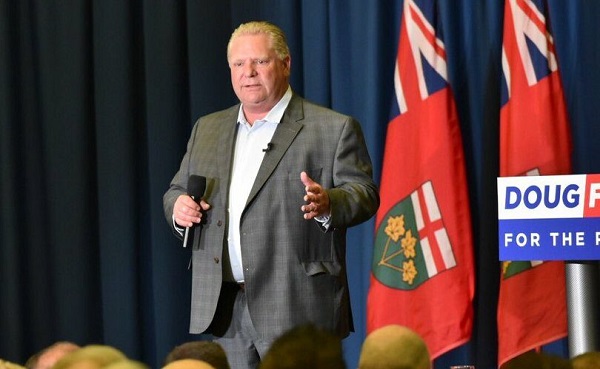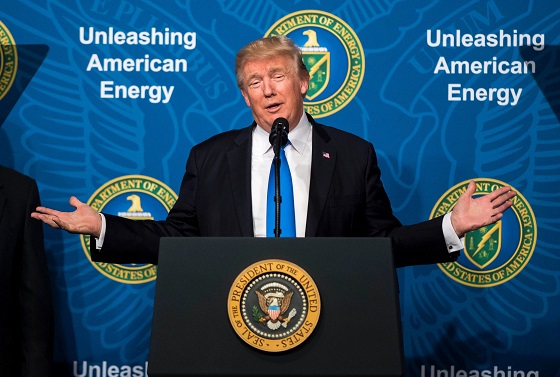National
Doug Ford’s Conservatives win Ontario snap election

From LifeSiteNews
An election called to address Donald Trump’s threat to annex Canada leads to Ontario Conservatives’ third majority government under Doug Ford.
The Progressive Conservative Party has won its third majority under leader Doug Ford.
On February 27, Progressive Conservative Party leader Doug Ford won 80 out of the 124 seats, securing his third majority government in a snap election called to address U.S. President Donald Trump’s threats to annex Canada and turn the country into the 51st state.
“Together, we have secured a strong, historic third majority mandate to protect Ontario,” Ford told his supporters at a victory party.
The premier paid tribute to the patriotism of politicians from the other Ontario parties, stating that “each one” loves both the province and Canada itself.
“We can disagree on policy, but there’s no question, no question at all: each one of them loves our province, and each one of them loves Canada, the greatest country on Earth,” he continued.
According to Elections Ontario’s unofficial results, Ford’s Conservatives received 2,158,452 votes, about 42%.
The Ontario New Democratic Party (NDP) received the next highest number of seats at 27. The Ontario Liberal Party got 14.
The New Blue Party, a pro-life, pro-family, and pro-freedom party, did not secure a seat but received 80,245 votes. The Ontario Party, which is both pro-family and pro-freedom, received 26,262 votes.
When Ford called the election, he told voters he wanted “a strong mandate” before embarking on what he sees as a difficult time in Ontario’s history.
“We’re entering a period of unprecedented economic risk and lengthy negotiations – against President Trump and with the federal government and other provinces. Responding to this challenge will demand extraordinary action,” Ford wrote Tuesday afternoon on X.
“To protect Ontario, I’m asking the people for a strong mandate – a strong, stable, four-year mandate that will outlive and outlast the Trump administration.”
Agriculture
Farmers Take The Hit While Biofuel Companies Cash In

From the Frontier Centre for Public Policy
Canada’s emissions policy rewards biofuels but punishes the people who grow our food
In the global rush to decarbonize, agriculture faces a contradictory narrative: livestock emissions are condemned as climate threats, while the same crops turned into biofuels are praised as green solutions argues senior fellow Dr. Joseph Fournier. This double standard ignores the natural carbon cycle and the fossil-fuel foundations of modern farming, penalizing food producers while rewarding biofuel makers through skewed carbon accounting and misguided policy incentives.
In the rush to decarbonize our world, agriculture finds itself caught in a bizarre contradiction.
Policymakers and environmental advocates decry methane and carbon dioxide emissions from livestock digestion, respiration and manure decay, labelling them urgent climate threats. Yet they celebrate the same corn and canola crops when diverted to ethanol and biodiesel as heroic offsets against fossil fuels.
Biofuels are good, but food is bad.
This double standard isn’t just inconsistent—it backfires. It ignores the full life cycle of the agricultural sector’s methane and carbon dioxide emissions and the historical reality that modern farming’s productivity owes its existence to hydrocarbons. It’s time to confront these hypocrisies head-on, or we risk chasing illusory credits while penalizing the very system that feeds us.
Let’s take Canada as an example.
It’s estimated that our agriculture sector emits 69 megatonnes (Mt) of carbon dioxide equivalent (CO2e) annually, or 10 per cent of national totals. Around 35 Mt comes from livestock digestion and respiration, including methane produced during digestion and carbon dioxide released through breathing. Manure composting adds another 12 Mt through methane and nitrous oxide.
Even crop residue decomposition is counted in emissions estimates.
Animal digestion and respiration, including burping and flatulence, and the composting of their waste are treated as industrial-scale pollutants.
These aren’t fossil emissions—they’re part of the natural carbon cycle, where last year’s stover or straw returns to the atmosphere after feeding soil life. Yet under United Nations Intergovernmental Panel on Climate Change (IPCC) guidelines adopted by Canada, they’re lumped into “agricultural sources,” making farmers look like climate offenders for doing their job.
Ironically, only 21 per cent—about 14 Mt—of the sector’s emissions come from actual fossil fuel use on the farm.
This inconsistency becomes even more apparent in the case of biofuels.
Feed the corn to cows, and its digestive gases count as a planetary liability. Turn it into ethanol, and suddenly it’s an offset.
Canada’s Clean Fuel Regulations (CFR) mandate a 15 per cent CO2e intensity drop by 2030 using biofuels. In this program, biofuel producers earn offset credits per litre, which become a major part of their revenue, alongside fuel sales.
Critics argue the CFR is essentially a second carbon tax, expected to add up to 17 cents per litre at the pump by 2030, with no consumer rebate this time.
But here’s the rub: crop residue emits carbon dioxide, methane and nitrous oxide whether the grain goes to fuel or food.
Diverting crops to biofuels doesn’t erase these emissions: it just shifts the accounting, rewarding biofuel producers with credits while farmers and ranchers take the emissions hit.
These aren’t theoretical concerns: they’re baked into policy.
If ethanol and biodiesel truly offset emissions, why penalize the same crops when used to feed livestock?
And why penalize farmers for crop residue decomposition while ignoring the emissions from rotting leaves, trees and grass in nature?
This contradiction stems from flawed assumptions and bad math.
Fossil fuels are often blamed, while the agricultural sector’s natural carbon loop is treated like a threat. Policy seems more interested in pinning blame than in understanding how food systems actually work.
This disconnect isn’t new—it’s embedded in the history of agriculture.
Since the Industrial Revolution, mechanization and hydrocarbons have driven abundance. The seed drill and reaper slashed labour needs. Tractors replaced horses, boosting output and reducing the workforce.
Yields exploded with synthetic fertilizers produced from methane and other hydrocarbons.
For every farm worker replaced, a barrel of oil stepped in.
A single modern tractor holds the energy equivalent of 50 to 100 barrels of oil, powering ploughing, planting and harvesting that once relied on sweat and oxen.
We’ve traded human labour for hydrocarbons, feeding billions in the process.
Biofuel offsets claim to reduce this dependence. But by subsidizing crop diversion, they deepen it; more corn for ethanol means more diesel for tractors.
It’s a policy trap: vilify farmers to fund green incentives, all while ignoring the fact that oil props up the table we eat from.
Policymakers must scrap the double standards, adopt full-cycle biogenic accounting, and invest in truly regenerative technologies or lift the emissions burden off farmers entirely.
Dr. Joseph Fournier is a senior fellow at the Frontier Centre for Public Policy. An accomplished scientist and former energy executive, he holds graduate training in chemical physics and has written more than 100 articles on energy, environment and climate science.
Frontier Centre for Public Policy
Notwithstanding Clause Is Democracy’s Last Line Of Defence

From the Frontier Centre for Public Policy
Amid radical rulings like Cowichan, Section 33 remains a vital tool for protecting property rights, social and economic stability, and legislative sovereignty in Canada.
The Notwithstanding Clause reminds Canadians that voters, not judges, make the final call
Alberta Premier Danielle Smith recently invoked Section 33 of the Charter of Rights and Freedoms to end a teachers’ strike and prevent endless litigation. The Alberta Teachers’ Association and the provincial NDP have called it tyranny. But a government using lawful authority is not tyranny.
Section 33, known as the “Notwithstanding Clause,” is a constitutional safeguard. It allows legislatures to pass laws that override certain Charter rights for up to five years. It was built into the Charter deliberately to ensure that elected representatives, not judges, remain supreme on fundamental issues.
The modern Left despises this clause because it breaks their playbook. When they cannot win in Parliament, they turn to the courts. For 50 years, judges have helped them shift policy by interpreting rights creatively. Section 33 blocks that route. That is why they hate it.
They smear it as a tool of the far right. The facts say otherwise. Allan Blakeney, the Saskatchewan NDP premier, helped enshrine it in 1982. The Parti Québécois, under René Lévesque, at the time the most leftist government in Canada, made heavy use of it. They understood something their successors pretend to forget: democracy rests with voters, not with the judiciary, with all due respect to the judiciary.
Blakeney and Alberta’s Peter Lougheed saw the danger. Federally appointed judges, immune from electoral consequence, could render decisions that uproot regional jurisdiction. Section 33 was the firewall. It recognized that while courts serve justice, legislatures serve people.
Two recent rulings show why that firewall matters. First, the Supreme Court struck down mandatory minimum sentences for child pornography in a 5-4 ruling.
Weeks earlier, in August 2025, Justice Barbara Young of the B.C. Supreme Court ruled that the Cowichan Tribes held unextinguished Aboriginal title to nearly 2,000 acres in Richmond, B.C. That land includes homes, businesses, public utilities and Crown land. The court declared Indigenous title overrides existing property rights, even without treaties or compensation.
The ruling makes every deed in that area, many of which were granted by the Crown over a century ago, subject to Justice Young’s retroactive reinterpretation. Your mortgage may rest on land you no longer legally own. Your lease may be invalid. Your development project unsellable. This is not a theory. It is a ruling.
No economy can function under such uncertainty. Property rights are foundational to free markets. If land ownership depends on a judge’s view of historical use, markets freeze. Banks will not lend. Builders will not build. The Cowichan decision casts a shadow over every titled parcel in British Columbia. Its precedent will not stay local.
B.C. Premier David Eby has chosen to appeal but that will take years. Meanwhile, risk deepens. Capital flees from uncertainty. No investor waits patiently while the Supreme Court ponders first principles.
This is the moment Section 33 was designed for. Its use would freeze the legal effect of Cowichan while legislatures restore order. If the prime minister will not act, others must. Premiers should signal now that property rights will be upheld. If not, the chaos of one courtroom may become a national affliction.
The Cowichan ruling, for all its disruption, may be a clarifying gift. It shows Canadians what radical judicial overreach looks like. Even those who trust the courts may now see why elected governments need the power to say: enough.
Blakeney put it plainly: “What matters is who makes the choices. I would be happy if legislatures gave courts all the deference, as long as legislatures were free to make the major governmental decisions.”
That freedom must now be used. Section 33 is not an act of aggression. It is the return of decision-making to where it belongs. In the aftermath of Cowichan, the country cannot wait years while property confidence erodes.
Section 33 is the remedy.
Marco Navarro-Genie is vice-president of research at the Frontier Centre for Public Policy and co-author, with Barry Cooper, of Canada’s COVID: The Story of a Pandemic Moral Panic (2023).
-

 Business17 hours ago
Business17 hours agoCBC cashes in on Carney as the news industry playing field tilts further in its favour, crippling the competition
-

 Energy2 days ago
Energy2 days agoThawing the freeze on oil and gas development in Treaty 8 territory
-

 Business2 days ago
Business2 days agoWhat Pelosi “earned” after 37 years in power will shock you
-

 Agriculture9 hours ago
Agriculture9 hours agoFarmers Take The Hit While Biofuel Companies Cash In
-

 Business2 days ago
Business2 days agoOttawa should stop using misleading debt measure to justify deficits
-

 Agriculture18 hours ago
Agriculture18 hours agoThe Canadian Food Inspection Agency’s Bloodlust for Ostriches: Part 2
-

 International2 days ago
International2 days agoBBC uses ‘neutrality’ excuse to rebuke newscaster who objected to gender ideology
-

 International2 days ago
International2 days agoLarge US naval presence in Caribbean reveals increased interest in western security


